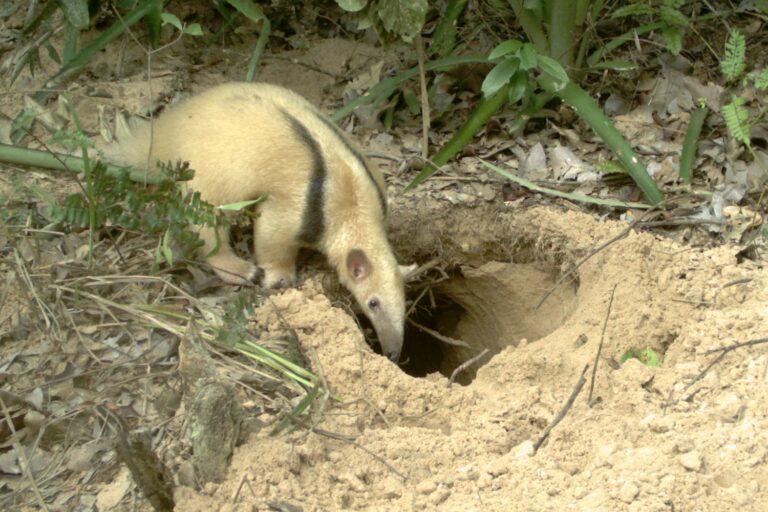Wherever it goes, the giant armadillo leaves behind not just footprints, but also burrows. These expertly dug tunnels are later used by various animals. One of them is the lesser anteater. After a decade of monitoring with camera traps in southern Pantanal, researchers present the surprising hypothesis that the small mammal uses the burrows not just for shelter, but also as feeding sites. Additionally, they may help anteaters maintain thermal comfort during moments of extreme temperature in the Pantanal biome.
The study, published in late January in the Journal of Zoology, was conducted by researchers from the Wild Animal Conservation Institute (ICAS) and the Federal University of Mato Grosso do Sul (UFMS), and provides the first detailed evaluation of how a species benefits from the giant armadillo’s burrows.
The research monitored the use of 379 giant armadillo (Priodontes maximus) burrows in the southern Pantanal, between the municipalities of Corumbá and Aquidauana, from 2011 to 2020. Images captured by camera traps showed some activity by lesser anteaters (Tamandua tetradactyla) in 127 of these burrows, about a third of the total. On average, these spaces were used on more than three separate occasions.

In some of the videos, you can see the animals sniffing and scratching the burrow entrances – an unprecedented behavior that researchers believe may indicate a search for food. The scientists hypothesize that the giant armadillos’ digging exposes insects living in the soil, providing a perfect meal for anteaters, whose diet mainly consists of ants and termites.
However, the most common use of the burrows was for extended periods of sleep. In some cases, anteaters stayed in the underground shelters for more than 22 hours. The choice of burrows may be linked to a strategy for better thermal comfort, as they can reach up to five meters in length and 1.5 meters in depth, ensuring thermal stability in the hot and often dry Pantanal environment.
These shelters are even more valuable to lesser anteaters due to their slow metabolism and difficulty regulating body temperature, explain the researchers. “Especially in such a challenging environment like the Pantanal, where temperatures can be extreme and there’s significant seasonal variation,” adds biologist Matheus Yan from UFMS, one of the study’s authors.
Endangered Engineer
Considered an ecosystem engineer due to its ability to alter the environment, the giant armadillo benefits not only the lesser anteaters. Arnaud Desbiez, president of ICAS and also a co-author of the study, highlights that over 100 species of vertebrates and more than 300 species of invertebrates have already been documented using the burrows.
“The giant armadillo is a true ecosystem engineer, creating shelters that benefit a wide range of species. Conserving this species is essential not only for its own survival but also to maintain the ecological balance of the Pantanal,” explains Desbiez.
The giant armadillo is the largest species among the group. Widely distributed across Brazil in different biomes, it can be found also from northern Argentina to Colombia, in South America. The species is considered vulnerable to extinction by IUCN Red List due to factors such as habitat loss, fragmentation and degradation of natural areas, hunting for meat and wildlife vehicle collisions.
According to the national brazilian assessment by the Chico Mendes Institute for Biodiversity Conservation (ICMBio), it is estimated that at least 30% of the species’ population has been lost in the country over the last three generations of giant armadillos due to these threats.
Protecting the giant armadillo and its burrows affects the survival of different wildlife species – not only in the Pantanal. For the lesser anteater, it serves as a climate-controlled bedroom with a potential food source. And all of this comes without paying rent.
This story was originally published in Portuguese. The translation to English was done with the assistance of Artificial Intelligence, with final review by a human. For this story, the review was done by the reporters Duda Menegassi and Vinicius Nunes.
As informações apresentadas neste post foram reproduzidas do Site O Eco e são de total responsabilidade do autor.
Ver post do Autor








